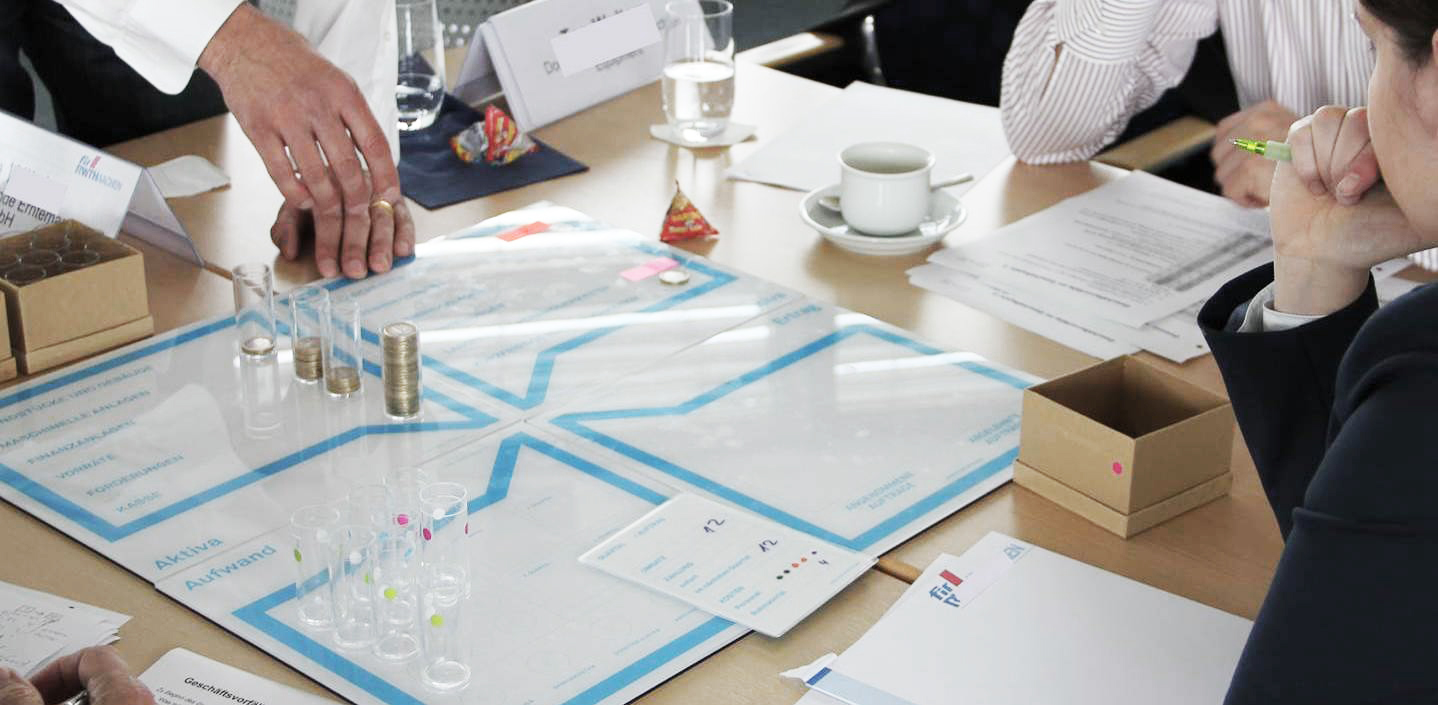Board Game Simulation

The business simulation board game
Running a company is basically easy: Invest cash and generate even more cash! A board game shows in a very transparent way how this value-adding activity works. And while you see (and hear) your cash growing you acquire a lot of new knowledge about financing and investing, about working capital management, value-based controlling, marketing strategy and resource management, about EBIT, RoI, WACC, about portfolio management and personnel management, about balance sheet, income statement and cashflow statement and much more.
Business simulations
Stock market simulation
„Nobody knows the real value of an asset.“ A stock market simulation illustrates the price fixing and the price variations on the capital markets and shows how money can be made and lost on the trading floor. Sometimes out of virtually nothing. Participants can experience the thin line between professional trading and betting. Between big money and financial fallout.
Electronic business simulation
The big advantage of electronic business simulations is their realistic and complex approach: The different company functions and divisions can be illustrated in a very sophisticated way, and participants have the possibility to apply many decision challenges from their everyday experience: design and implement corporate strategies, control marketing, sales, and services, comprehend financial situations, manage personnel, team performance, and leadership. Electronic business simulations map the complexity of everyday business challenges better on the one hand, on the other hand, though, they require a basic understanding of the value-chain structure of corporations. If this knowledge basis is given sophisticated and differentiated business scenarios can be simulated which participants have to deal with in real competitive situations. Electronic business simulations can be very well customized to specific customer needs and goals.
Process simulation
In every company smooth and efficient business processes are a critical factor for financial success. Process simulations make participants design and built up business processes, which they then have to operate cost and time effective. The process content can be very well customized to the respective needs: building and marketing light weight paper planes, the (very time critical) process of handling securities trading within a bank, building complex LEGO figures, etc. The focus may be efficient resource management, speed, accuracy, or even an especially attentive cooperation. And it´s always about profitability in competitive environments.
Fund management
More in shares or more in fixed income? How much cash? Conservative or value-oriented? For you and me or for the multi-billion pension fund? This simulation shows the decision scope in fund management. Regarding an economic environment, inflation indices, and central bank policy, fundamental and chart analysis data. The competitive target is to increase the return or even beat the index. Very enlightening.
Success factors for game-based learning
Gain experience
Business simulations map decision challenges form company and people management. They give a framework to test and prove ones own behavior in a sheltered environment. No other learning tool is so powerful in delivering an opportunity to develop and a learning experience – both in hard skill and soft skill topics. Several success factors are:
It is not a game
Only when participants realize the practical relevance of the simulation used they will be willing to participate and invest motivation and engagement. So both concept and content, used terms and definitions as well as discussion level have to fit to the target group.
Backed-up with up-to-date management knowledge
Not the simulation but the delivered leadership knowledge is in the focus. The simulation is only to bring the content into a life situation.
Target oriented
Both method and content of the simulation have to be transparent as well as embedded in a clear didactical message. Only then practical relevance will be perceived.
Falling is allowed
Learning by doing. Mistakes, bad performance, inappropriate behavior, etc. is to be held secure within the seminar room and among the trustful environment of the participant group.
Active participation is the success factor
Content and scope of the simulation are closely customized to the target group. Only then participants will be motivated to join in. There is no other learning method with higher grades of engagement and fun!
Not an assessment
The goal of he simulation is not to assess peoples performance. Participants are to prove and try out their knowledge and behavior in a secure environment. They shall have the freedom to learn from mistakes. And that is only possible in a distinct culture of learning and development.
A challenging scenario
Simulation model and acitivity are to challenge the knowledge and behavior of the participants. “You grow with your goals!”
The target is financial performance
Team performance and leadership quality, customer satisfaction and process management – even simulation models which are focused on qualitative aspects are at the end also targeted to a financial performance indicator. Because only sustainable value-oriented corporate management will secure the long-term existence of any company.